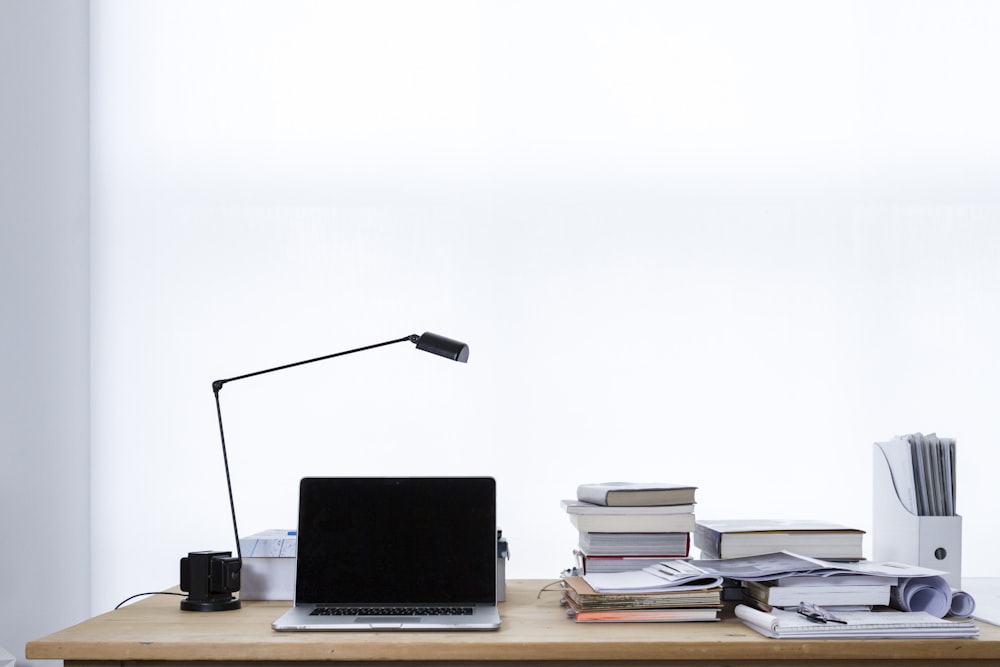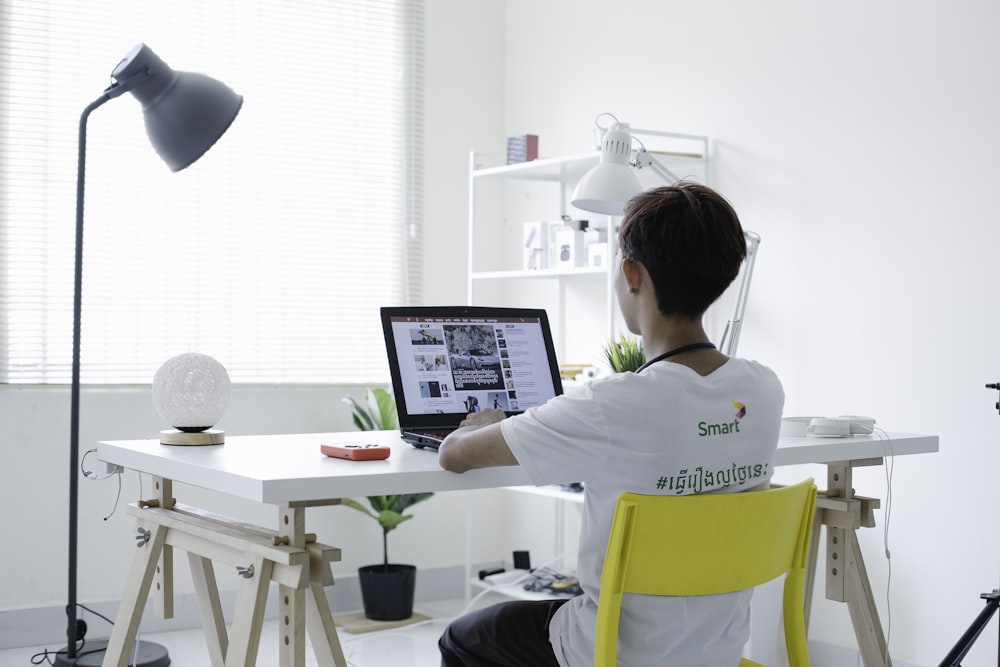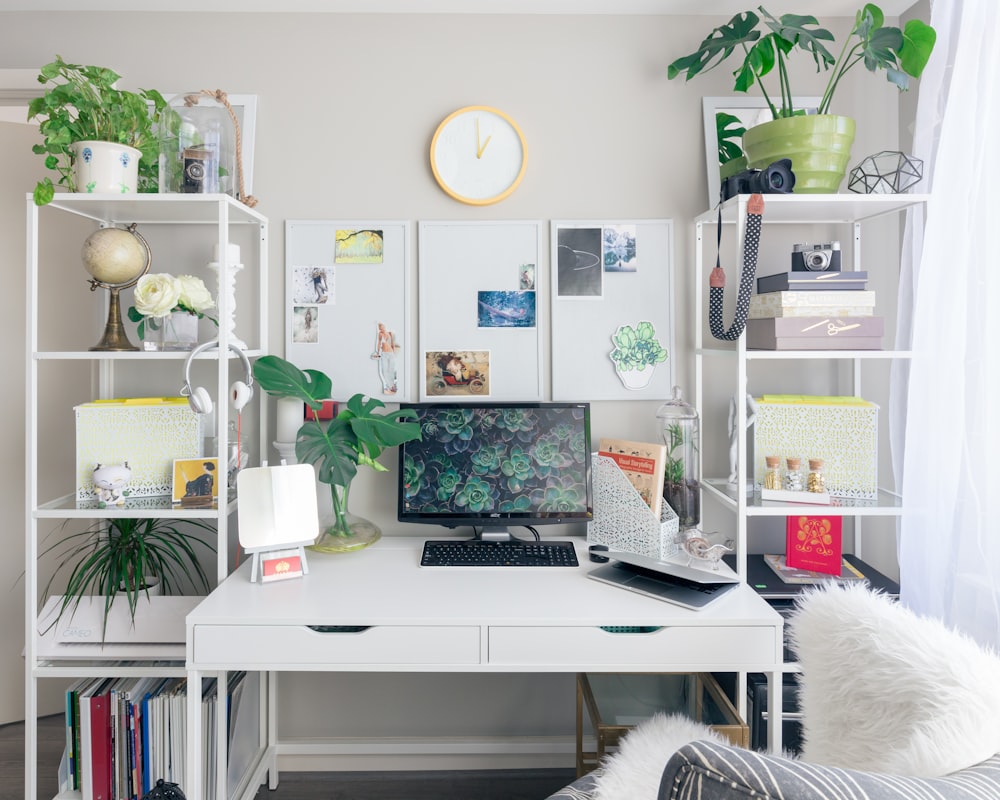Welcome to our guide on designing a minimalist workspace for maximum focus and productivity. In today’s fast-paced world, it can be challenging to stay focused and productive amidst the constant distractions and clutter. That’s where minimalist workspace design comes in. By creating a clean, organized, and visually appealing workspace, you can optimize your productivity and enhance your overall well-being.
Imagine walking into a workspace that is free from clutter, well-lit, and thoughtfully designed. A workspace that promotes a sense of calm and clarity, allowing you to focus on the task at hand without any unnecessary distractions. Sounds amazing, right? Well, with a few simple tips and tricks, you can turn this vision into a reality.
In this article, we’ll delve into the concept of minimalism in workspace design and explore the impact of clutter on productivity. We’ll also discuss the role of office design trends such as biophilic offices and activity-based workspaces in enhancing productivity. Finally, we’ll provide you with practical tips for designing a minimalist workspace that fosters maximum focus and productivity.
So, whether you’re working from a home office or a traditional workplace, this article is here to help you transform your workspace into a haven of efficiency and inspiration. Get ready to create a space that boosts your concentration, fuels your creativity, and allows you to do your best work. Let’s dive in!
Understanding Minimalism in Workspace Design
In today’s fast-paced and cluttered world, creating a minimalist workspace has become increasingly popular. Minimalism is not just a design trend, but also a philosophy that focuses on simplicity, organization, and eliminating unnecessary distractions. When it comes to workspace design, embracing minimalism can significantly improve focus and productivity. So, let’s dive into the benefits of minimalist workspace design and how it can positively impact your work environment.
Effect of Clutter On Productivity
We’ve all experienced the frustration of trying to work in a cluttered and chaotic space. Not only does clutter make it difficult to find what we need, but it also has a negative impact on our productivity. In fact, a study conducted by the University of California, Berkeley, found that individuals working in cluttered environments were 40% less productive than those in clean and organized workspaces.
Clutter not only overwhelms our senses but also hampers our ability to focus and process information efficiently. By adopting a minimalist approach to your workspace design, you can eliminate unnecessary items and create a clean and organized environment that promotes clarity and enhances your ability to concentrate.
Importance of Natural Views
In addition to decluttering your workspace, incorporating natural views into your design can have a profound effect on your productivity and well-being. A study conducted by the University of Toronto revealed that individuals with a view of nature from their workspace were not only more productive but also exhibited higher levels of creativity.
Natural views have a calming effect on our brains and help to reduce stress levels. They provide a source of inspiration and connection to the outside world, which is especially important for those working long hours indoors. Whether it’s a window overlooking a scenic landscape or indoor plants that mimic the outdoors, adding natural elements to your workspace can have a positive impact on your focus and overall well-being.
“The natural environment is the cornerstone of human productivity, creativity, and well-being.” – Dr. Senay, Assistant Professor, University of British Columbia
By understanding the effects of clutter on productivity and the importance of natural views in workspace design, you can begin to create a minimalist workspace that fosters maximum focus and productivity. In the next section, we’ll explore the role of office design trends in achieving this goal. So, let’s dive in and explore the exciting possibilities of biophilic offices and activity-based workspaces.
The Role of Office Design Trends in Productivity
When it comes to designing a minimalist workspace for maximum focus and productivity, office design trends play a crucial role. Incorporating these trends in your workspace not only enhances the aesthetics but also contributes to a more productive and efficient work environment. Let’s explore two popular office design trends that have proven to boost productivity.
Biophilic Offices
Biophilic offices have gained significant popularity in recent years. This design trend focuses on incorporating elements of nature into the workspace. By bringing the outdoors indoors, biophilic offices aim to improve productivity, reduce stress, and boost creativity. Here are a few ways you can incorporate biophilic design in your workspace:
- Natural Elements: Incorporate natural materials such as wood, stone, and bamboo in your furniture and decor. This creates a sense of connection to nature.
- Plants: Add greenery to your workspace by placing indoor plants strategically. Plants not only enhance the aesthetics but also improve air quality and promote a sense of calmness.
- Natural Light: Maximize the use of natural light by positioning your workspace near windows or using light-colored curtains. Natural light has been proven to increase productivity and overall well-being.
Activity-Based Workspaces
Activity-based workspaces are designed to accommodate different work activities. Rather than having a traditional office setup with assigned desks, activity-based workspaces provide flexibility for employees to choose the most appropriate setting for their tasks. This design trend recognizes that individuals have different work styles and preferences. Here’s how you can implement activity-based workspaces:
- Collaborative Zones: Create designated areas where employees can collaborate and exchange ideas. These spaces can be equipped with whiteboards, comfortable seating, and technology for seamless communication.
- Quiet Zones: Allocate areas for focused work and concentration. These zones should have minimal distractions and provide a peaceful environment for employees to tackle complex tasks.
- Breakout Spaces: Include informal breakout spaces where employees can take short breaks, socialize, and recharge. These spaces can be furnished with cozy seating, games, and refreshments.
By introducing these design trends into your workspace, you can enhance productivity, creativity, and overall employee satisfaction. Remember, each organization is unique, so it’s essential to customize these trends to suit your company’s specific needs.
“Designing a workspace that reflects your company’s culture and provides the right environment for your employees is vital for productivity and well-being.” – John Smith, Workplace Consultant
In the next section, we will discuss practical tips for designing a minimalist workspace that maximizes focus and productivity. Let’s dive in!
Also Read: Minimalist Home Maintenance Tips in 2023 : Keeping Your Space Organized and Clutter-Free
Tips for Designing a Minimalist Workspace for Maximum Focus and Productivity
Designing a minimalist workspace can have a significant impact on your focus and productivity. By creating a clean and organized environment, you can eliminate distractions and create a space that promotes concentration and efficiency. In this article, we will explore some tips and strategies to help you design a minimalist workspace that maximizes your focus and productivity.
De-cluttering and Cleaning
- Start by decluttering your workspace and getting rid of any unnecessary items. A clutter-free environment can reduce stress and increase productivity.
- Organize your belongings in a way that is visually pleasing and easily accessible. Use storage solutions such as shelves, drawers, and bins to keep your workspace tidy.
- Regularly clean your workspace to maintain a fresh and inviting atmosphere. A clean environment can improve your mood and make it easier to focus on your tasks.
Choosing Simple Furniture
- Opt for simple and functional furniture that complements the minimalist aesthetic. Look for clean lines, neutral colors, and minimal embellishments.
- Avoid overcrowding your workspace with unnecessary furniture. Stick to the essentials, such as a desk, chair, and storage solutions.
- Invest in ergonomic furniture that promotes good posture and comfort. A comfortable workspace can enhance your focus and prevent physical discomfort.
Utilizing Natural Light
- Make the most of natural light by positioning your workspace near a window or skylight. Natural light has been shown to improve mood, boost productivity, and regulate sleep patterns.
- If natural light is limited, consider using task lighting that mimics daylight. This can help reduce eye strain and create a more inviting atmosphere.
- Avoid harsh overhead lighting, as it can create glare and cause fatigue. Opt for soft, diffused lighting options instead.
Adding Plants
- Incorporate plants into your workspace to bring a touch of nature indoors. Plants not only add aesthetic appeal but also have numerous benefits for productivity and well-being.
- Studies have shown that having plants in the workspace can improve air quality, reduce stress, and increase creativity. Choose low-maintenance plants that thrive indoors, such as succulents or pothos.
- Place plants strategically throughout your workspace, such as on your desk, shelves, or window sill.
Selecting a Comfortable Chair
- A comfortable chair is essential for maintaining good posture and preventing back pain. Look for a chair with adjustable height, lumbar support, and ergonomic features.
- Avoid chairs that are too soft or too firm, as they can cause discomfort and reduce productivity. Test different chairs to find one that suits your preferences and provides adequate support.
- Take regular breaks and stretch throughout the day to prevent sitting for long periods, even if you have a comfortable chair.
Personalizing the Space
- While minimalism emphasizes simplicity, it’s still important to personalize your workspace to make it inviting and inspiring.
- Add personal touches such as photos, artwork, or motivational quotes that resonate with you. Surrounding yourself with meaningful objects can help create a positive and motivating environment.
- However, be mindful not to overcrowd your workspace with excessive decorations. Keep it simple and choose items that are meaningful and contribute to a calm and focused mindset.
By implementing these tips and strategies, you can design a minimalist workspace that enhances your focus and productivity. Remember, minimalism is not just about aesthetics; it’s about creating a space that supports your mental and physical well-being. So, declutter, simplify, and create a workspace that inspires you to do your best work. Happy designing!
Also Read: Minimalism and Mental Health : The Impact of a minimalist Home Environment in 2023
Conclusion
In conclusion, designing a minimalist workspace can have a significant impact on your focus and productivity. By following the tips mentioned in this article, such as decluttering, choosing simple furniture, utilizing natural light, adding plants, selecting a comfortable chair, and personalizing the space, you can create an environment that promotes clarity of thought and enhances your work performance.
Remember, a clutter-free workspace helps to reduce stress and distractions, allowing you to concentrate on the task at hand. Incorporating elements of nature and utilizing office design trends like biophilic offices and activity-based workspaces can also contribute to increased productivity and creativity.
So, take the time to assess your workspace, get rid of unnecessary items, and create a minimalistic and organized setup. Your mind will thank you for it, and you’ll experience the benefits of enhanced focus and efficiency.
If you’re looking for more inspiration and guidance on achieving a minimalist aesthetic in your home, be sure to check out Minimalist Home Guru. Our experts cater to new home buyers who seek to create a calming and clutter-free living space. We offer valuable insights on decluttering, selecting clean-lined furniture, and achieving a minimalist lifestyle. Let us help you design the perfect sanctuary for peace and productivity.
Remember, minimalism is not just a design trend; it’s a lifestyle choice that brings simplicity, clarity, and tranquility into your life. Embrace it, and watch your productivity soar.
Frequently Asked Questions
- What is a minimalist workspace?A minimalist workspace is a clean and clutter-free work area that is designed to promote focus, simplicity, and productivity. It typically features minimal furniture, essential equipment, and a simplified aesthetic.
- Why is having a minimalist workspace important for focus and productivity?A minimalist workspace helps reduce distractions, creates a sense of calm, and promotes a clear and focused mindset. By eliminating unnecessary items and visual clutter, you can better concentrate on your tasks and enhance productivity.
- How can I design a minimalist workspace?To design a minimalist workspace, start by decluttering and organizing your current space. Remove non-essential items, choose a simple color palette, and invest in multifunctional furniture. Keep only the essential tools and equipment required for your work.
- What are some tips for maintaining a minimalist workspace?To maintain a minimalist workspace, regularly declutter and remove unnecessary items. Establish a system for organizing files and documents digitally. Avoid accumulating items that do not serve a specific purpose. Regularly review and reevaluate your workspace to ensure it remains minimalist.
- Can a minimalist workspace improve creativity?Yes, a minimalist workspace can enhance creativity by reducing distractions and creating a clean and open environment that allows for clear thinking and idea generation. It can help you focus on the essential aspects of your work, leading to increased creativity and productivity.




